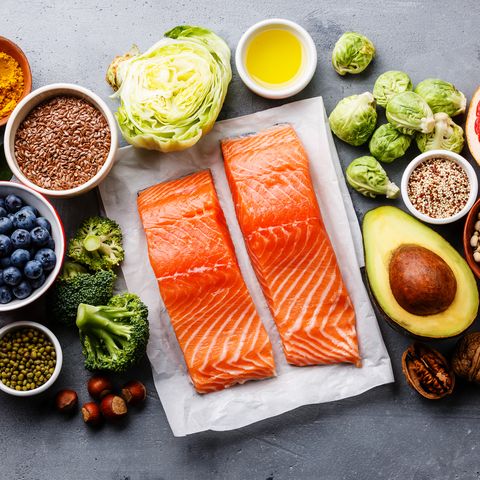

Honestly, who can keep track of all the ‘tarians that exist these days? There are vegetarians, flexitarians, pescetarians. Don’t even get me started on pegans. But seriously—which one is best if you can’t give up spicy tuna rolls?
Basically, if you like the idea of slashing your meat intake but have a LTR with salmon, the pescatarian diet may be for you. People who follow the plan eat a wide variety of plant-based foods, like fruits, vegetables, legumes, whole grains, and nuts—plus fish and seafood.
Whether you eat dairy and eggs on the pescatarian diet is up to you. Some keep them in their weekly rotation, while others opt out. Totally off the table: red meat, poultry, pork, and turkey.
This might sound similar to the popular Mediterranean diet, but there’s one major difference: Red meat is allowed (in moderation) on the Med diet. You’re also supposed to avoid packaged foods on that plan, while the pescatarian diet doesn’t have a specific policy on store-bought stuff. Otherwise, there’s a lot of overlap: Seafood, fresh produce, and plant-based proteins are mainstays of both eating plans.
Is going pescatarian worth it?
Unless you can’t live without steak, there’s a lot to love about the pescatarian diet. “You’ll reap the nutritional benefits of a plant-based diet, as well as the nutritional benefits of fish and seafood,” says Emily Kyle, R.D.N.
Basically, pescatarians get all of the antioxidant- and vitamin-rich produce vegetarians do, while also getting some nutrients (like complete proteins and omega-3 fatty acids) from seafood that are harder to take in on a strictly plant-based diet.
For example, while many vegetarians and vegans may struggle to get their fill of vitamin B12 (found primarily in animal protein), “pescatarians are able to meet their daily requirements for B12 with a single serving of most fish varieties,” says Georgia Rounder, R.D.N.

Also key: Seafood is one of the best sources of heart- and brain-healthy omega-3 fatty acids. “Omega-3 fatty acids may decrease inflammation in the body and lower both blood pressure and triglycerides,” says Rounder. You can get omega-3s from plant-based sources like flaxseeds, but it’s harder than just eating an order of salmon and calling it a day.
“This diet has also been associated with decreasing the risk for other chronic diseases, including diabetes, dementia, and depression,” adds Rounder, thanks to the boost of omega-3s you get when fish is your main source of protein.
Other people, of course, choose it for sustainability reasons, animal-rights concerns, or just personal preference, adds Kyle.
What about all that mercury tho?
One important thing to keep in mind: Being pescatarian doesn’t mean you have to load up your plate with fish each meal—you can actually eat a carnivorous diet and consume more fish (and more mercury) than someone who’s pescatarian. But if you do consume a lot of seafood—regardless of which diet you follow—you’ll want to avoid eating high-mercury fish all day every day to minimize your risk of mercury poisoning.

Eat swordfish, tilefish, shark, King Mackerel, and large quantities of albacore tuna in moderation, says Rounder—especially if you’re pregnant or breastfeeding.
That said, low-mercury seafood options, including canned light tuna, cod, clams, salmon, and catfish, are generally less of a cause for concern. “The most common fish that we eat on a daily basis are [low in mercury], meaning that in general the pescatarian diet is safe for most individuals,” says Kyle.
Whether you’re pescatarian or not, The American Heart Association recommends eating two servings of fish a week. And mix it up so that you’re eating a variety of seafood—that will further reduce your risk of consuming too much mercury.
The bottom line: Go ahead and try the pescatarian diet if you’re interested. For most people, the health benefits of eating a plant-based diet plus fish far outweighs the potential risks.
Source: Read Full Article